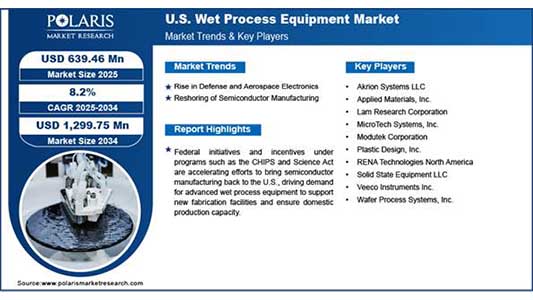The U.S. wet process equipment market is important for the manufacturing of semiconductors and advanced materials. Wet process equipment is widely used for cleaning and surface preparation of wafers and PCBs. The U.S. is witnessing increased demand for high-performance chips and renewable energy devices. The introduction of favorable government policies supporting domestic semiconductor manufacturing is further driving the adoption of advanced wet processing solutions.
Wet Process Equipment: Introduction
Water process equipment refers to specialized machinery that’s used in the manufacturing of semiconductors, electronics, and advanced materials. It depends on chemical-based liquid processing for cleaning, etching, or preparing substrates. Wet process systems make use of chemical baths and sprays to remove contaminants and modify surface properties with high precision.
Types of Wet Process Equipment
Etching Equipment
Etching equipment is essential for the manufacturing of semiconductor devices. It selectively removes material layers from wafer to create complex circuit patterns. Wet etching involves the use of chemical solutions for dissolving specific areas of the substrate. This makes it a cost-effective and highly uniform process than that of dry plasma etching. Wet etching doesn’t have the high precision of dry methods. However, its essential in applications that needs high throughput and low costs.
Cleaning Equipment
Cleaning equipment is essential for ensuring that the manufacturing of semiconductor and electronics is defect-free. These tools enable the removal of organic residues and metal contaminants. It also helps eliminate microscopic particles that can compromise on the performance of the device. Wet cleaning methods often take the form of immersion baths and spray tools. Chemical rinsing methods that allow superior cleanliness at the nanoscale level are also included.
Plating Equipment
Plating equipment is widely used for the deposition of thin metallic films on wafers and substrates. Electroplating is important for the formation of conductive pathways for interconnected and advanced packaging. Electroless plating allows for uniform coating even on complex geometries. These systems are important for applications such as 3D packaging and wafer manufacturing.
Surface Preparation Systems
Surface preparation systems are designed to condition substrates before crucial steps like deposition and lithography. These systems improve surface adhesion and enhance pattern fidelity by modifying the physical or chemical properties of the substrate surface. Processes may take the form of chemical cleaning and oxide growth control. Effective surface preparation helps reduce defect rates and ensures the repeatability of the process.
Market Metrics
The U.S. wet process equipment market size stood at USD 591.55 million in 2024, according to the latest assessment by Polaris Market Research. The market is projected to grow at a CAGR of 8.2% from 2025 to 2034.
Market Growth Drivers
Semiconductor Industry Growth
The growth of the semiconductor industry is fueling the demand for wet process equipment across the U.S. Increased demand for advanced consumer electronics and 5G-enabled devices means semiconductor fabs need highly efficient etching and surface preparation tools. Wet process systems play an important role in ensuring defect-free wafers and reliable device performance. The U.S. strengthening its role in the global semiconductor value chain has led to consistent need for precision manufacturing solutions. This is fueling demand for wet process equipment across leading fabs and contract foundries.
Government Investments and CHIPS Act
Federal initiatives have resulted in large-scale investments in domestic semiconductor manufacturing and research and development. The CHIPS Act provides significant fundings in the form of subsidies and incentives for expanding fabrication facilities and improving research capabilities. This has created a favorable environment for the manufacturers of wet process equipment. The reason behind this is that fabs being built or upgraded in the U.S. will need advanced cleaning and plating systems.
View More Information @ https://www.polarismarketresearch.com/industry-analysis/us-wet-process-equipment-market/request-for-sample
Emerging Market Trends
Shift Toward Single-Wafer Processing
Traditional batch systems are still widely used in semiconductor fabs. However, the industry is shifting towards single-wafer wet processing. Single-wafer systems offer tighter process control and reduce the risk of cross-wafer contamination. It also ensures uniformity in crucial steps such as cleaning and etching. These advantages are highly important as the geometries of devices continue to shrink.
Integration of Automation and Robotics
Automation is becoming a key aspect of modern wet process development. Advanced wet branches now make use of robotic wafer handling and automated chemical delivery. The use of these systems helps improve throughput and safety. It also helps reduce human error. Robotics-enabled handling reduces the breakage of fragile wafers and ensures repeatability in highly sensitive processes.
Conclusion
The U.S. wet process equipment market supports the nation’s growing semiconductor and electronics industries. The demand is driven by advancements in consumer electronics and electric vehicles. Federal initiatives such as the CHIPS and Science Act are further strengthening domestic production capabilities. At the same time, trends such as single-wafer processing and adoption of advanced materials are changing the industry landscape.
Read More @ www.polarismarketresearch.com












